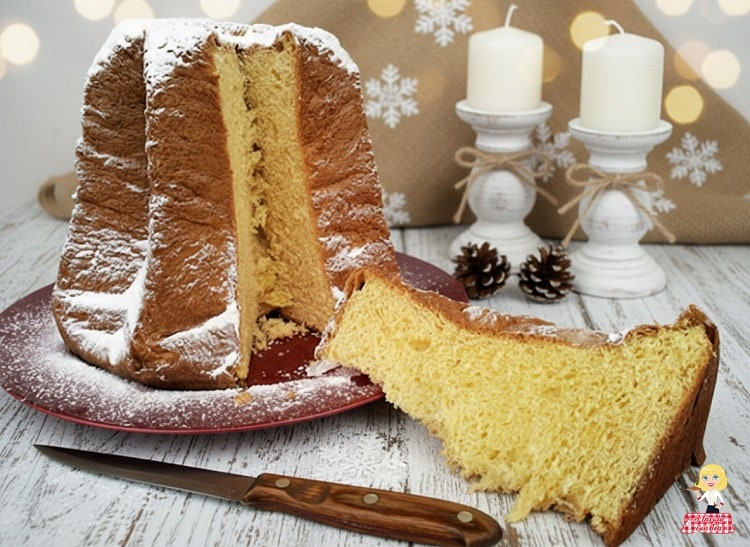Homemade Pandoro: The Original Recipe, Easy and Very Soft
I confess, for years I thought that preparing homemade Pandoro was an endeavor fit only for great pastry masters. The idea of such a complex leavened seemed an insurmountable obstacle.
But I had to change my mind, and with a bit of courage and a lot of passion, I discovered that the original Pandoro recipe is absolutely within everyone’s reach, even for those who are not professionals.
Certainly, it requires a good dose of patience, because the rising phases are different and you cannot hurry. But the beauty is just that: the time is not spent ‘brooding’ the dough, but is used to do a thousand other things, while it magically grows on its own.
It’s almost a therapeutic experience, an activity that connects you to the pleasure of creating something extraordinary with your hands.
And I guarantee you that it is really worth it. The satisfaction of baking your own Pandoro, with its unmistakable aroma that invades the house, is unparalleled.
It’s an emotion that takes me back to the genuine flavors of the holidays. So, take a day, take it easy, and enjoy every phase of this small great adventure.
I assure you that you will not regret it!
The Best Homemade Pandoro Recipe: Soft and Delicious
If you’re in the mood to prepare Christmas desserts, also try

- Difficulty: Medium
- Cost: Medium
- Preparation time: 45 Minutes
- Portions: 1.65 lbs
- Cooking methods: Oven
- Cuisine: Italian
- Seasonality: Christmas
- Energy 399.88 (Kcal)
- Carbohydrates 50.91 (g) of which sugars 18.08 (g)
- Proteins 8.92 (g)
- Fat 18.51 (g) of which saturated 11.34 (g)of which unsaturated 6.73 (g)
- Fibers 1.11 (g)
- Sodium 66.09 (mg)
Indicative values for a portion of 3 g processed in an automated way starting from the nutritional information available on the CREA* and FoodData Central** databases. It is not food and / or nutritional advice.
* CREATES Food and Nutrition Research Center: https://www.crea.gov.it/alimenti-e-nutrizione https://www.alimentinutrizione.it ** U.S. Department of Agriculture, Agricultural Research Service. FoodData Central, 2019. https://fdc.nal.usda.gov
ORIGINAL HOMEMADE PANDORO RECIPE INGREDIENTS
- 0.88 oz all-purpose flour
- 0.88 oz Manitoba flour
- 1 tsp dry yeast
- 1/4 cup milk
- 1 egg yolk
- 1 oz sugar
- 3.53 oz all-purpose flour
- 3.53 oz Manitoba flour
- 1 egg (whole)
- 3/4 tsp dry yeast
- 1 oz butter
- 4.23 oz sugar
- 1/8 cup milk
- 4.06 oz all-purpose flour
- 4.06 oz Manitoba flour
- 2 eggs (whole)
- 1 pinch salt
- 2 tsp vanilla extract
- 4.94 oz butter
- 0.71 oz butter (melted)
- powdered sugar (for decoration)
Tools
- 3 Bowls
- Mold for Pandoro
Steps
Put 1.76 oz of flour (half all-purpose and half Manitoba) with 1 tsp of dry yeast in a bowl and mix. In another bowl, pour an egg yolk, 1 oz of sugar, and 1/4 cup of warm milk, and mix. Gradually add the flour with the yeast into the liquid bowl. Cover with plastic wrap and let rise for about an hour, it should double in volume.
In another bowl, mix 7.05 oz of flour (half all-purpose and half Manitoba) with 3/4 tsp of dry yeast.
To the pre-dough prepared first, add 1 whole egg, 4.23 oz of sugar, 1/8 cup of warm milk, and 1 oz of softened butter, and give it a good mix. Then gradually add the flour mixed with yeast (prepared at the beginning of this step) and mix. Cover again with plastic wrap and let it rise for about an hour, or until doubled.Resume the dough, add 2 whole eggs, one at a time, and mix. Add a pinch of salt and the vanilla extract and mix. At this point, gradually incorporate 8.12 oz of flour (half all-purpose and half Manitoba) into the dough. Mix well and when the dough becomes firm, transfer it to a lightly floured work surface and knead, absorbing all the flour well. Place the dough in a lightly buttered bowl, cover with plastic wrap, and let it rise until doubled (about 1 hour).
After the time has passed, transfer the dough to the refrigerator and let it rest for about 12-14 hours. After the time in the fridge, take out the dough and leave it at room temperature for about 1 hour before working it. Then transfer it to a floured work surface and, using a rolling pin, shape it into a square. Place 4.94 oz of softened cubed butter in the center of the square. Fold the 4 corners towards the center and seal. Then fold the square in half forming a rectangle. Finally, fold the rectangle in 3 parts and let it rest in the fridge for 20 minutes covered with plastic wrap.
After the time, take the dough again and roll it out again. Fold it onto itself 3 more times and let it rest in the fridge each time for 15 minutes. Finally, roll out the dough one last time, shaping it into a square. Fold the corners towards the inside, flip it over, and shape it into a ball. Place it inside a well-buttered 750g Pandoro mold. Brush with 0.71 oz of melted butter, cover with plastic wrap, and let it rise for the last time in a warm place for about 3 hours (the dough should reach the edges of the mold).
Bake in a preheated ventilated oven at 320°F. After the time, cover the surface with aluminum foil, lower the temperature to 266°F, and continue baking for another 45 minutes. Remove from the oven and let the Pandoro cool before decorating with plenty of powdered sugar.

NOTES
Always let the dough rise in a warm environment away from drafts. Rising times are indicative and vary according to the ambient temperature (to adjust, consider that the various doughs must always double in volume).

